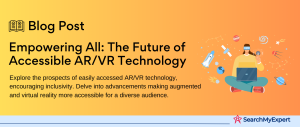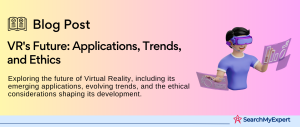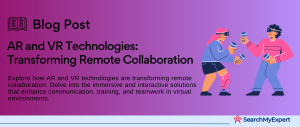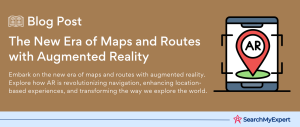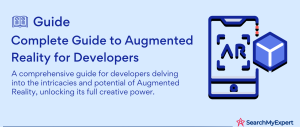Virtual Reality (VR) in Art and Creativity: A New Horizon
Virtual Reality (VR), once a figment of science fiction, has now blossomed into a groundbreaking technology. It transcends the traditional boundaries of perception, offering an immersive experience that is reshaping how we interact with digital content.
Core Features of VR
- Immersive Experience:
VR creates a fully digital environment, a 360-degree experience that engulfs the senses. - Interactivity: Users can interact with the virtual world in real-time, offering a dynamic experience.
- Sensory Engagement:
Through visual, auditory, and sometimes haptic feedback, VR engages multiple senses, enhancing realism.
VR Meets Art and Creativity
The fusion of VR and art is not just an intersection; it’s a vibrant collision of worlds, birthing new forms of expression. Artists are now equipped with tools to craft experiences that were once unimaginable. This blend is revolutionizing the art world in several ways:
- Expanded Canvas:
Artists are no longer constrained by physical space. VR provides an infinite canvas for exploration. - Interactive Art:
Audience engagement transcends passive observation. Viewers can interact with and influence the art itself. - New Perspectives:
VR art offers unique perspectives, enabling viewers to step inside the artwork and experience it from multiple angles.
The Potential of VR in Artistic Expression and Engagement
VR is not just a new tool for artists; it’s a paradigm shift in how we conceive and experience art. This technology holds the potential to:
- Revolutionize Storytelling: With VR, narratives can become immersive experiences, with the audience as active participants.
- Enhance Educational Opportunities:
Art education can leverage VR to provide hands-on experiences in a virtual environment. - Global Accessibility: VR bridges geographical gaps, allowing people worldwide to access and experience art without physical constraints.
Virtual Reality is not just transforming art; it’s redefining the very essence of creative expression and audience interaction. As we step into this new era, the possibilities are as boundless as the virtual worlds we can create.
Immersive Art Creation in VR: Redefining Boundaries
In the realm of art and creativity, Virtual Reality (VR) is not just a tool; it’s a revolution. It transforms the flat canvas into a living, breathing 3D world, where artists become sculptors of virtual spaces, and the lines between painting, sculpting, and digital creation blur.
The Leap from 2D to 3D
- Breaking Physical Limits: In VR, artists aren’t confined to physical materials or spaces. They can create and manipulate objects in a truly three-dimensional space.
- Sensory Immersion:
This medium is not just visual; it’s a multi-sensory experience. Artists can create works that not only are seen but are experienced.
Tools of the Trade: VR in the Artist’s Toolkit
- Tilt Brush: This Google-developed tool allows artists to paint in 3D space with virtual brushes, creating vibrant and dynamic works that float in the air.
- Quill by Oculus: Quill emphasizes precision and detail, enabling artists to create intricate, illustrative works in a virtual environment.
- Oculus Medium:
A sculpting tool that lets artists mold, shape, and build in a virtual space as if they were working with real clay.
VR Art in Action: Installations and Exhibitions
- Interactive Exhibitions:
Museums and galleries are adopting VR to showcase digital installations, allowing visitors to step into and interact with art in a way never before possible. - Global Showcases:
Online platforms are hosting VR art exhibitions, making these unique creations accessible to a global audience. - Collaborative Creations:
VR enables artists from different parts of the world to collaborate in a shared virtual space, creating artworks that are a fusion of diverse cultural perspectives.
VR in art is not just an extension of the existing mediums; it’s a whole new dimension of creativity. As artists continue to explore and master these tools, we’re witnessing a renaissance in how art is created, experienced, and shared.
Redefining Storytelling and Performance through VR
The Evolution of Narrative
In the dynamic landscape of Virtual Reality (VR), the art of storytelling is undergoing a profound transformation. Traditional linear narratives are giving way to immersive, interactive experiences that invite the audience to step inside the story and become part of it.
VR and Interactive Storytelling
- Beyond the Screen:
With VR, the story envelops the viewer, creating a 360-degree world that’s rich in detail and alive with possibilities. - Choose Your Path: Interactive VR narratives often allow viewers to influence the story’s direction, leading to multiple endings and a personalized experience.
- Emotional Engagement: The immersive nature of VR creates a powerful emotional connection, making the story more impactful and memorable.
VR Theater and Performances
- VR Theater Experiences:
Theater productions are using VR to transport audiences to other worlds, blending live performance with digital environments. - Multi-Sensory Performances: Some VR experiences incorporate real-world elements like touch, smell, and temperature, enhancing the sense of presence and immersion.
- Audience Participation: In VR, the line between performer and spectator blurs. Audience members can become active participants, influencing or even becoming part of the performance.
Case Studies in VR Storytelling
- “The Supperclub”:
This VR experience allows participants to become guests at a surreal dinner party, where each choice leads to a different narrative twist. - “Carne y Arena” (Flesh and Sand):
Directed by Alejandro González Iñárritu, this groundbreaking VR installation places viewers in the shoes of migrants and refugees, creating a deeply personal and emotional journey.
Through these innovations, VR is not just changing the way stories are told; it’s changing the very nature of narrative, turning passive viewers into active participants in a shared, living story. As technology advances, the line between story and reality continues to blur, opening up new possibilities for creativity and connection.
Democratizing Art Appreciation and Accessibility Through VR
Bridging the Physical Divide
Virtual Reality (VR) is not just revolutionizing art creation; it’s also transforming how art is accessed and appreciated. With VR, geographical and physical barriers to experiencing art are dissolving, enabling broader access than ever before.
VR Art Exhibits and Virtual Tours
- Virtual Access to Galleries and Museums:
VR technology allows users to virtually visit galleries and museums across the globe. From the Louvre to the MoMA, art becomes accessible to anyone with a VR headset. - Interactive Exhibitions:
These virtual tours are often more than mere walkthroughs. They can include interactive elements, such as clickable information plaques and audio guides, enhancing the educational aspect.
Enhancing Art Appreciation for People with Disabilities
- Inclusive Experiences: VR can be tailored to provide accessible art experiences for people with various disabilities. For example, haptic feedback can help visually impaired users feel the art, while subtitles and sign language avatars can assist those with hearing impairments.
- Art Education: VR can play a vital role in art education, offering immersive learning experiences that are both engaging and accessible.
The potential of VR to democratize art appreciation lies in its ability to transcend traditional limitations. It’s not just about making art more accessible; it’s about opening up new ways for people to connect with and experience the beauty and diversity of human creativity.
The Challenges and Concerns in VR Art and Creativity
Navigating the Technical Landscape
While Virtual Reality (VR) offers immense potential in art and creativity, it’s not without its challenges. These obstacles can range from technical limitations to broader social and ethical concerns.
Technical Limitations and Accessibility Issues
- Hardware Requirements:
High-quality VR experiences often require sophisticated and sometimes expensive equipment, which can be a barrier for many users. - Quality of Experience:
The fidelity of VR environments varies greatly. Lower-quality experiences can detract from the immersive aspect and may even cause discomfort.
Social Isolation and Sensory Overload
- Isolation Concerns: Prolonged use of VR can lead to a sense of isolation, as users are cut off from the physical world and social interactions.
- Sensory Overload:
VR can be intense, especially for first-time users. Overstimulation can lead to discomfort or disorientation.
Ownership and Monetization of VR Art
- Copyright and Ownership: The digital nature of VR art raises complex questions about copyright, ownership, and reproduction rights.
- Monetization Models: How artists can monetize VR art is still an evolving question. The lack of established platforms and models for VR art sales and display poses a challenge for creators.
As VR continues to grow in the field of art and creativity, addressing these challenges is crucial. Balancing technological innovation with accessibility, user well-being, and fair compensation for artists will be key to the sustainable development of VR as a medium for artistic expression.
The Future of VR in Art: A Canvas of Infinite Possibilities
Envisioning Tomorrow’s VR Technology
The future of Virtual Reality (VR) in art is not just an extension of what we see today; it’s a realm of untapped potential, where the boundaries between reality and imagination become increasingly blurred.
Advancements in VR and Impact on Art
- Enhanced Realism: Future VR technology is likely to offer even more realistic and immersive experiences. This could include better haptic feedback, more lifelike visuals, and improved auditory inputs.
- Accessible and Affordable:
As technology progresses, VR equipment is expected to become more accessible and affordable, making it easier for artists and audiences alike to dive into VR art.
Immersive and Interactive Art Experiences
- Deeper Immersion:
Advancements in VR will allow for even deeper levels of immersion, making virtual art experiences almost indistinguishable from reality. - Interactive Evolution:
The interactivity of VR art will evolve, allowing for more complex and engaging participatory experiences for the audience.
The Convergence with Other Technologies
- AI Integration:
The merger of VR with AI could lead to dynamic art that changes and evolves in response to viewer interactions or external data. - Cross-Platform Experiences: The future might see a blend of VR with other technologies like AR (Augmented Reality) and MR (Mixed Reality), creating multi-layered art experiences.
The potential of VR in the art world is as boundless as the imagination. As technology evolves, it will not just change how we experience art; it will transform the very nature of what art can be. The future of VR in art is a horizon that continually expands, promising a landscape of creativity that is ever-evolving, ever-surprising, and endlessly fascinating.
The Transformative Journey of VR in Art and Creativity
As we conclude our exploration of Virtual Reality (VR) in the realm of art and creativity, it’s clear that VR is not just a new tool or medium. It’s a transformative force, redefining the boundaries of artistic expression and audience engagement.
Key Takeaways
- Revolutionizing Art Creation: VR allows artists to transcend traditional mediums, offering a 3D canvas where the only limit is imagination.
- Immersive Storytelling:
Through VR, narratives become interactive and immersive experiences, engaging audiences in unprecedented ways. - Democratizing Art Access:
VR breaks down geographical and physical barriers, making art accessible to a wider audience, including those with disabilities. - Challenges and Considerations: Despite its potential, VR faces technical, social, and ethical challenges that need careful navigation.
The Transformative Potential for Artists and Audiences
For artists, VR opens a new frontier of creative possibilities, where they can craft experiences that were once impossible. For audiences, it offers a new way of experiencing art, breaking free from passive observation to active participation.
A Hopeful Outlook on the Future of VR-Powered Artistic Expression
The future of VR in art is a canvas of infinite possibilities. As technology advances, we can expect even more immersive and interactive art experiences, potentially integrated with AI and other cutting-edge technologies. This journey of VR in art is not just about technological advancement; it’s about a cultural shift towards more inclusive, dynamic, and engaging forms of artistic expression.
VR in art and creativity is a journey into a world where reality and imagination merge, offering a glimpse into a future where art is not just seen but truly experienced.
Conclusion
Virtual Reality (VR) is revolutionizing the art world, offering artists an expansive new canvas and transforming how audiences engage with art. It’s breaking down barriers to accessibility, making art more inclusive and interactive. As we look forward, VR’s role in art promises even more groundbreaking advancements, reshaping the landscape of creativity and storytelling.
Make your mark in the virtual world with AR & VR Development Service Companies.
Table of Contents
Toggle

